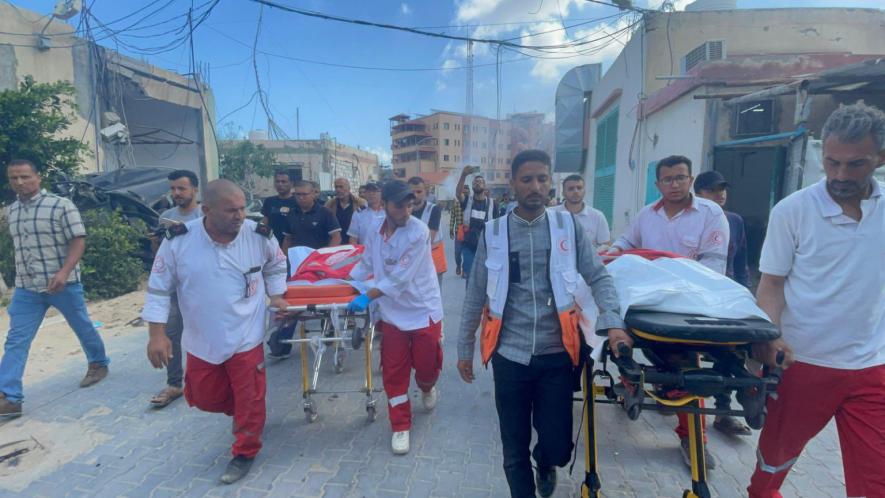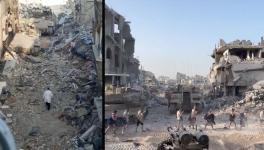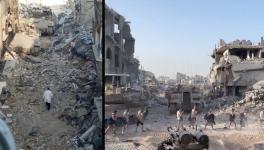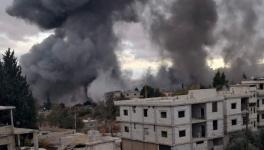Lancet Letter Estimates as Many as 186,00 Deaths in Gaza

Palestinian Red Crescent crews mourn fellow paramedics Haitham Tubasi and Suhail Hassouna, killed by Israeli forced (Photo via PRCS)
“It is not implausible to estimate that up to 186,000 or even more deaths could be attributable to the current conflict in Gaza,” reads a letter published in The Lancet, penned by Rasha Khatib, Martin McKee, and Salim Yusuf on July 5. “Using the 2022 Gaza Strip population estimate of 2,375,259, this would translate to 7-9% of the total population in the Gaza Strip.”
These shocking numbers have renewed the global accusations of genocide against the state of Israel, which since October 7 has waged a brutal war against the people of Gaza.
“These are apocalyptic figures,” stated Dr. Ghassan Abu Sitta, celebrated Palestinian surgeon who operated on victims of Israeli aggression in Gaza at the outbreak of violence following October 7.
These figures come as a report was published in the Israeli +972 Magazine, that the Israeli Army has essentially approved unrestricted violence against Palestinians by their soldiers. Sources cited in the report described being permitted to commit indiscriminate violence against Palestinians. “I personally fired a few bullets for no reason, into the sea or at the sidewalk or an abandoned building,” said an IOF reservist who was stationed in Gaza. “They report it as ‘normal fire,’ which is a codename for ‘I’m bored, so I shoot.’”
This latest estimate takes into account the official death toll coming from Gaza’s Ministry of Health, the credibility of which has been called into question by the likes of Joe Biden as well as by Israeli authorities, despite being accepted by Israeli intelligence as well as international bodies such as the UN and the WHO. As of June 19, the Ministry of Health reported 37,396 people killed in the Gaza Strip.
The wide gap between the letter’s 186,000 estimate and the official death toll comes for a variety of reasons. These include the widespread destruction of infrastructure on the strip, leading to difficulties in estimating the death toll. Many of those included in the official death toll are unidentifiable bodies—as of May, 30% of 35,091 deaths were unidentifiable.
The letter suggests that it is likely that the Gaza Health Ministry is undercounting deaths, rather than overcounting, unlike what many detractors claim. “The non-governmental organization Airwars undertakes detailed assessments of incidents in the Gaza Strip and often finds that not all names of identifiable victims are included in the Ministry’s list,” the letter states.
Another way in which the estimate of 37,396 could be a far lower number than the reality is the large number of bodies missing under the rubble, as 35% of Gaza’s buildings have been destroyed by Israel according to UN estimates. The UN also estimates that as many as 10,000 bodies are buried under the rubble, unable to be assessed for official death counts.
The letter also introduces the large amount of deaths that could be attributed to causes indirectly related to military violence. These include disease and hunger as more and more of Gaza’s population becomes displaced, forced to contend with the elements. As People’s Health Dispatch reported back on June 28, “The most recent analytical snapshots published by the Integrated Food Security Phase Classification (IPC) foresee that in the period between mid-June and the end of September, 96% of the people in Gaza will face acute malnutrition or have to forgo other essential needs to procure the minimum necessary amounts of food.”
“The total death toll is expected to be large given the intensity of this conflict; destroyed health-care infrastructure; severe shortages of food, water, and shelter; the population’s inability to flee to safe places; and the loss of funding to UNRWA, one of the very few humanitarian organizations still active in the Gaza Strip,” writes the letter. “In recent conflicts, such indirect deaths range from three to 15 times the number of direct deaths.”
The letter ends by calling for an immediate ceasefire, as well as the distribution of humanitarian needs.
Get the latest reports & analysis with people's perspective on Protests, movements & deep analytical videos, discussions of the current affairs in your Telegram app. Subscribe to NewsClick's Telegram channel & get Real-Time updates on stories, as they get published on our website.
























